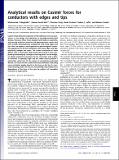Analytical results on Casimir forces for conductors with edges and tips
Author(s)
Emig, Thorsten; Graham, Noah; Faghfoor Maghrebi, Mohammad; Rahi, Sahand Jamal; Jaffe, Robert L.; Kardar, Mehran; ... Show more Show less
DownloadKardar-2011-April-Analytical results on Casimir.pdf (738.4Kb)
PUBLISHER_POLICY
Publisher Policy
Article is made available in accordance with the publisher's policy and may be subject to US copyright law. Please refer to the publisher's site for terms of use.
Terms of use
Metadata
Show full item recordAbstract
Casimir forces between conductors at the submicron scale are paramount to the design and operation of microelectromechanical devices. However, these forces depend nontrivially on geometry, and existing analytical formulae and approximations cannot deal with realistic micromachinery components with sharp edges and tips. Here, we employ a novel approach to electromagnetic scattering, appropriate to perfect conductors with sharp edges and tips, specifically wedges and cones. The Casimir interaction of these objects with a metal plate (and among themselves) is then computed systematically by a multiple-scattering series. For the wedge, we obtain analytical expressions for the interaction with a plate, as functions of opening angle and tilt, which should provide a particularly useful tool for the design of microelectromechanical devices. Our result for the Casimir interactions between conducting cones and plates applies directly to the force on the tip of a scanning tunneling probe. We find an unexpectedly large temperature dependence of the force in the cone tip which is of immediate relevance to experiments.
Date issued
2011-04Department
Massachusetts Institute of Technology. Department of PhysicsJournal
Proceedings of the National Academy of Sciences of the United States of America
Publisher
National Academy of Sciences
Citation
Maghrebi, M. F. et al. “Analytical results on Casimir forces for conductors with edges and tips.” Proceedings of the National Academy of Sciences 108 (2011): 6867-6871. Web. 9 Nov. 2011. © 2011 National Academy of Sciences
Version: Final published version
ISSN
0027-8424
1091-6490